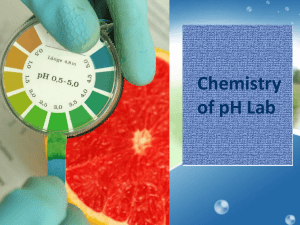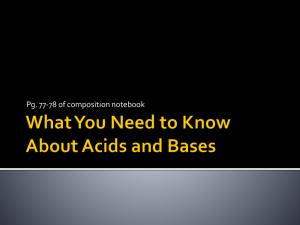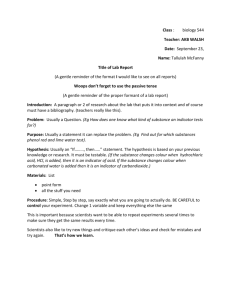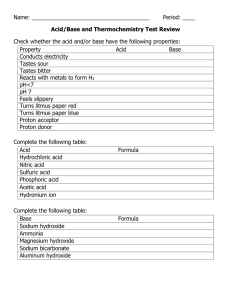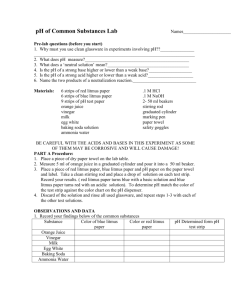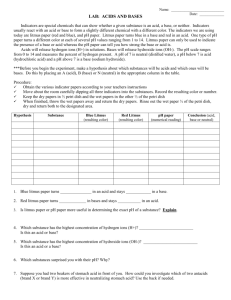Lab Session 11, Experiment 10: AcidBase Indicators
advertisement
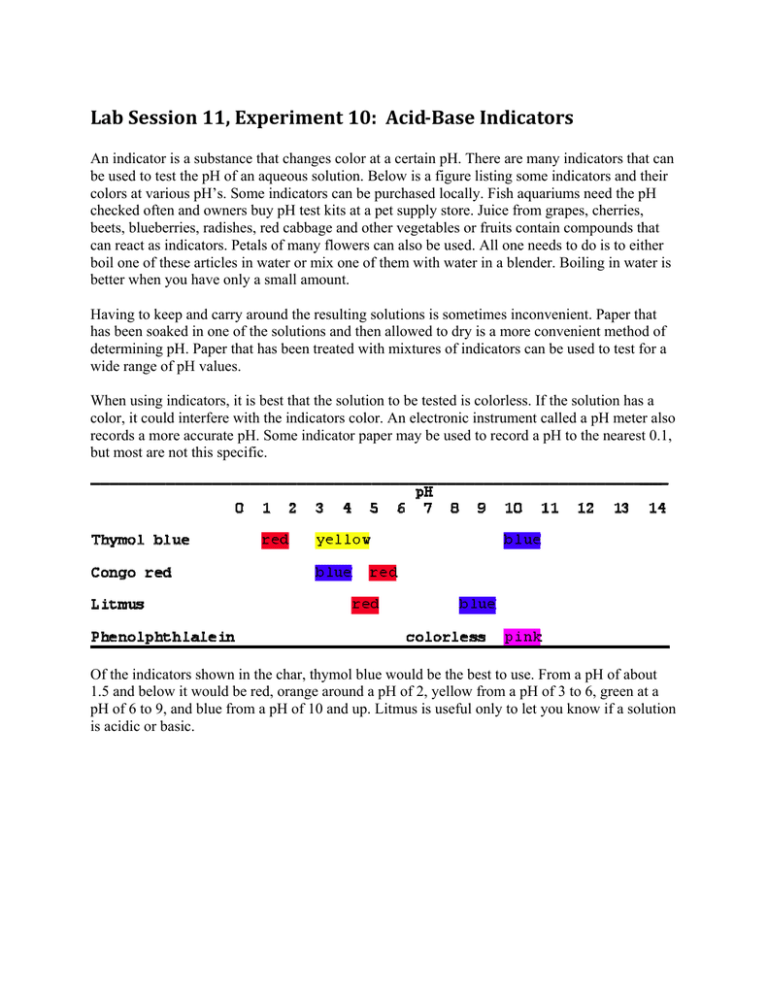
Lab Session 11, Experiment 10: Acid­Base Indicators An indicator is a substance that changes color at a certain pH. There are many indicators that can be used to test the pH of an aqueous solution. Below is a figure listing some indicators and their colors at various pH’s. Some indicators can be purchased locally. Fish aquariums need the pH checked often and owners buy pH test kits at a pet supply store. Juice from grapes, cherries, beets, blueberries, radishes, red cabbage and other vegetables or fruits contain compounds that can react as indicators. Petals of many flowers can also be used. All one needs to do is to either boil one of these articles in water or mix one of them with water in a blender. Boiling in water is better when you have only a small amount. Having to keep and carry around the resulting solutions is sometimes inconvenient. Paper that has been soaked in one of the solutions and then allowed to dry is a more convenient method of determining pH. Paper that has been treated with mixtures of indicators can be used to test for a wide range of pH values. When using indicators, it is best that the solution to be tested is colorless. If the solution has a color, it could interfere with the indicators color. An electronic instrument called a pH meter also records a more accurate pH. Some indicator paper may be used to record a pH to the nearest 0.1, but most are not this specific. Of the indicators shown in the char, thymol blue would be the best to use. From a pH of about 1.5 and below it would be red, orange around a pH of 2, yellow from a pH of 3 to 6, green at a pH of 6 to 9, and blue from a pH of 10 and up. Litmus is useful only to let you know if a solution is acidic or basic. 11A Experiment Aqueous Solutions Used: HCl, hydrochloric acid NaOH, sodium hydroxide CH3COOH, acetic acid (vinegar) NaHCO3, sodium bicarbonate (baking soda) NH3, ammonia Sprite (or 7-UP) Tap water Red cabbage juice Procedure: 1. Get the following items: Dropper bottles containing the first 6 solutions in the above list, 7 test tubes, test tube rack, stirring rod, 2 pieces of red litmus paper, 2 pieces of blue litmus paper, 2 strips of wide-range pH paper, wash bottle. 2. Put a drop of HCl(aq) on one of the pieces of red litmus paper; then put a drop of HCl(aq) on one of the pieces of blue litmus paper. Record which litmus paper did not change color and which did. Record the new color. Getting wet is not a color change. When treated with an acid, red litmus paper ________________. When treated with an acid, blue litmus paper _______________. 3. Put a drop of NaOH(aq) on the other piece of red litmus paper; then put a drop of NaOH(aq) on the other piece of blue litmus paper. Record which litmus paper did not change color and which did. Record the new color. Getting wet is not a color change. When treated with an base, red litmus paper ________________. When treated with an base, blue litmus paper _______________. 4. Put a drop of HCl(aq) on the wide-range pH paper. There is a pH/color chart for this indicator paper. Record the pH below. Do the same for each of the other solutions. HCl NaOH CH3COOH NaHCO3 NH3 Sprite Tap Water pH _____________________________ _____________________________ ______________________________ ______________________________ ______________________________ ______________________________ ______________________________ 5. Add a dropper-full of red cabbage juice to each of the 7 test tubes. Add 20 drops of a solution to one of these test tubes. Stir with the stirring rod. Record the color produced. Rinse off the stirring rod and do this procedure for each solution. Color HCl ___________________________________ NaOH ___________________________________ CH3COOH ___________________________________ ___________________________________ NaHCO3 NH3 ___________________________________ Sprite __________________________________ Tap Water __________________________________ 11A Questions/Exercise 1. Fill in the pH and corresponding color for the indicator. Use the information from #4 and #5 to help complete this chart. Color pH | wide-range paper | cabbage juice NaOH _______________ | __________ |_______________ HCl ___________________ | __________ |_______________ Tap Water _______________ | _________ |_______________ Acetic acid _____________ | ___________ |_______________ Ammonia _____________ | ____________ |_______________ Sodium bicarbonate _____________ | _____________ |_______________ Sprite _______________|__________________|_______________ 2. From your answers in question #1, does the color of the indicator depend on the pH, or does the pH depend on the color of the indicator? 3. If you were making a pH/color chart for cabbage juice (like the one used for the wide-range paper), what would be the data given? Fill in the following chart to answer this question. pH NaOH HCl Tap Water Acetic acid Ammonia Sodium bicarbonate Sprite color ________________________________________ ________________________________________ ________________________________________ ________________________________________ ________________________________________ ________________________________________ ________________________________________ 4. What type of solution (acidic or basic) will make blue litmus change to red? 5. What type of solution (acidic or basic) will make red litmus change to blue? 6. For the tested solutions, write the names and formulas of the acids. Do not use the grocery store names. 7. For the tested solutions, write the names and formulas of the bases. Do not use the grocery store names. 8. Which of the basic solutions was the most basic? 9. Which of the acidic solutions was the most acidic? 10. Know the chemical names, grocery store names, and the corresponding formulas. Why do you say this? Why do you say this?
